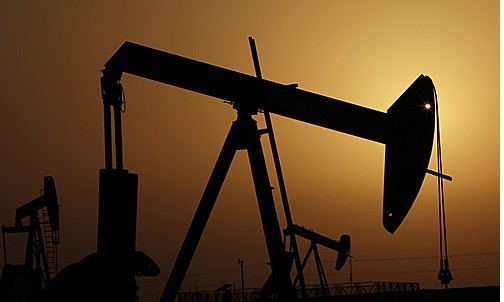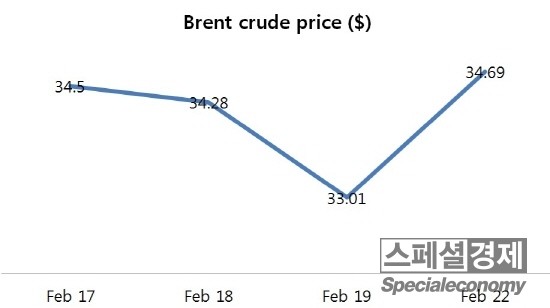
[Special Economy=Eunji Kim]The roller-coaster ride of the world oil prices continues; the forecast that American Shale oil production will slow down signalled a jump in these numbers on Monday.
On that day, West Texas Intermediate (WTI) rose $1.84 (6.2%) and traded at $31.48. In the middle of the trade, WTI even jumped 8%, going as far as recording at $32, but come afternoon, the increasing range minimized.
Brent crude, on the other hand, bounced $1.68 (5.09%) at $34.69. Looking at the situation, the International Energy Agency (IEA) released a prediction report on this day that estimated a cut in Shale production. According to IEA, this amount will decrease at 600,000 barrels per day and next year, 200,000 additional barrels will be cut daily.
Furthermore, the forecast is that the oil stockpile will rise to 100,000 barrels per day, stopping at this level, and in 2018, there will be a 400,000 barrel decrease.
Compare this to last year’s daily increase of 2 million barrels, it shows for large reduction.

Currently, OPEC and Saudi Arabia are playing a dangerous chicken game. Saudi Arabia, the biggest oil-producing country for the last two years, and OPEC have rather hiked their production. Since shale prices are more expensive, if Saudi doesn’t do a cut, it can lead its competition to go bankrupt; Russia too is maintaining their greatest production rate.
However, there is a catch in IEA’s prediction: when oil prices rebound, everything can go back to square one.
Secretary-general of OPEC, Abdalla Salem El-Badri, said on Monday’s annual IHS CERAWeek conference in Houston, that if we can’t find a solution to the problem of oversupply, this issue can continue for a number of years.
El-Badri also said that both OPEC and non-cartel countries are willing to work together to find that solution.
Although there is a suspicion that his words can only be a mere statement intended for a oil price recovery, and that cooperation can not occur, what he said can bring bearish effects to the current oil market.

현재 석유수출국기구 (OPEC)과 사우디아라비아는 위험한 치킨게임을 이어가고 있다. OPEC과 지난 2년간 최대 산유국인 사우디아라비아는 시장점유율을 지키기 위해 생산량을 오히려 늘려왔다. 미국 셰일 오일 가격이 더 비싸기 때문에 사우디아라비아가 생산량을 줄이지 않으면 셰일 업체의 부도를 유도할 수 있다는 것이다.
러시아도 마찬가지 최대 생산량을 지속적으로 유지하고 있다. IEA에 따르면 미국 셰일 오일 생산량이 단기적으로 감산되지만 유가가 반등한다면 다시 원점으로 돌아갈 수 있다고 말했다. 미국 셰일 오일 업체들 가운데 국제 유가가 50달러 아래에 머물더라도 수익을 낼 수 있는 곳이 있기 때문이다.
IEA는 올해 원유 개발 투자에 대한 전망도 내놨다. 이는 지난해 24% 감소됐고 올해도 17% 줄어들 것이라는 얘기다. 이는 1986년 이후 처음으로 2년 연속 감소한 것이다.
또한 베이커휴즈에 따르면 지난주 미국의 원유 시추기 가동건수는 413개에 그치며 2009년 이후 최저치 행진을 이어갔다.
압달라 살렘 엘-바드리 석유수출국기구(OPEC) 사무총장은 이날 개최된 회의에 참석해 “해결책을 찾지 못한다면 직면한 공급 과잉 문제가 수년간 지속될 수 있다”며 대책을 찾기 위해 비OPEC 회원국과 협력하겠다고 말했다.
그의 발언은 유가 회복세를 위한 의도적인 말일 수 도 있는 의구심이 제기되지만 현재 국제유가 시장에 호재 영향을 줄 수 있다는 전망이다.

